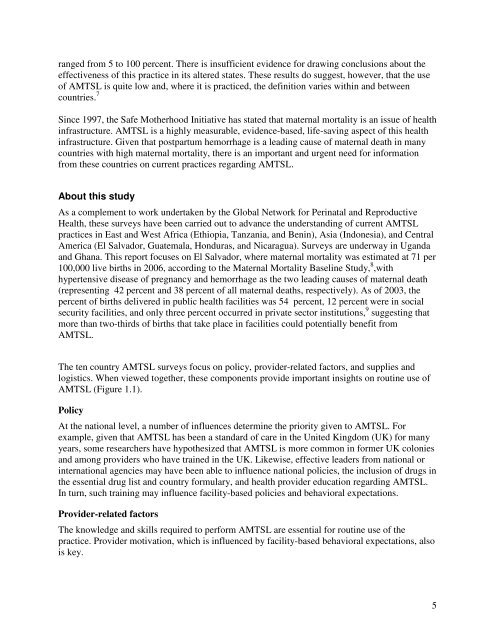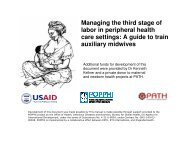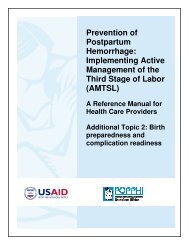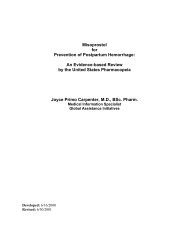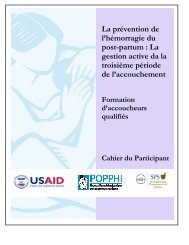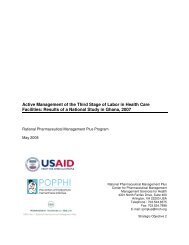El Salvador - Active Management of the Third Stage of Labor - POPPHI
El Salvador - Active Management of the Third Stage of Labor - POPPHI
El Salvador - Active Management of the Third Stage of Labor - POPPHI
You also want an ePaper? Increase the reach of your titles
YUMPU automatically turns print PDFs into web optimized ePapers that Google loves.
anged from 5 to 100 percent. There is insufficient evidence for drawing conclusions about <strong>the</strong>effectiveness <strong>of</strong> this practice in its altered states. These results do suggest, however, that <strong>the</strong> use<strong>of</strong> AMTSL is quite low and, where it is practiced, <strong>the</strong> definition varies within and betweencountries. 7Since 1997, <strong>the</strong> Safe Mo<strong>the</strong>rhood Initiative has stated that maternal mortality is an issue <strong>of</strong> healthinfrastructure. AMTSL is a highly measurable, evidence-based, life-saving aspect <strong>of</strong> this healthinfrastructure. Given that postpartum hemorrhage is a leading cause <strong>of</strong> maternal death in manycountries with high maternal mortality, <strong>the</strong>re is an important and urgent need for informationfrom <strong>the</strong>se countries on current practices regarding AMTSL.About this studyAs a complement to work undertaken by <strong>the</strong> Global Network for Perinatal and ReproductiveHealth, <strong>the</strong>se surveys have been carried out to advance <strong>the</strong> understanding <strong>of</strong> current AMTSLpractices in East and West Africa (Ethiopia, Tanzania, and Benin), Asia (Indonesia), and CentralAmerica (<strong>El</strong> <strong>Salvador</strong>, Guatemala, Honduras, and Nicaragua). Surveys are underway in Ugandaand Ghana. This report focuses on <strong>El</strong> <strong>Salvador</strong>, where maternal mortality was estimated at 71 per100,000 live births in 2006, according to <strong>the</strong> Maternal Mortality Baseline Study, 8 ,withhypertensive disease <strong>of</strong> pregnancy and hemorrhage as <strong>the</strong> two leading causes <strong>of</strong> maternal death(representing 42 percent and 38 percent <strong>of</strong> all maternal deaths, respectively). As <strong>of</strong> 2003, <strong>the</strong>percent <strong>of</strong> births delivered in public health facilities was 54 percent, 12 percent were in socialsecurity facilities, and only three percent occurred in private sector institutions, 9 suggesting thatmore than two-thirds <strong>of</strong> births that take place in facilities could potentially benefit fromAMTSL.The ten country AMTSL surveys focus on policy, provider-related factors, and supplies andlogistics. When viewed toge<strong>the</strong>r, <strong>the</strong>se components provide important insights on routine use <strong>of</strong>AMTSL (Figure 1.1).PolicyAt <strong>the</strong> national level, a number <strong>of</strong> influences determine <strong>the</strong> priority given to AMTSL. Forexample, given that AMTSL has been a standard <strong>of</strong> care in <strong>the</strong> United Kingdom (UK) for manyyears, some researchers have hypo<strong>the</strong>sized that AMTSL is more common in former UK coloniesand among providers who have trained in <strong>the</strong> UK. Likewise, effective leaders from national orinternational agencies may have been able to influence national policies, <strong>the</strong> inclusion <strong>of</strong> drugs in<strong>the</strong> essential drug list and country formulary, and health provider education regarding AMTSL.In turn, such training may influence facility-based policies and behavioral expectations.Provider-related factorsThe knowledge and skills required to perform AMTSL are essential for routine use <strong>of</strong> <strong>the</strong>practice. Provider motivation, which is influenced by facility-based behavioral expectations, alsois key.5


